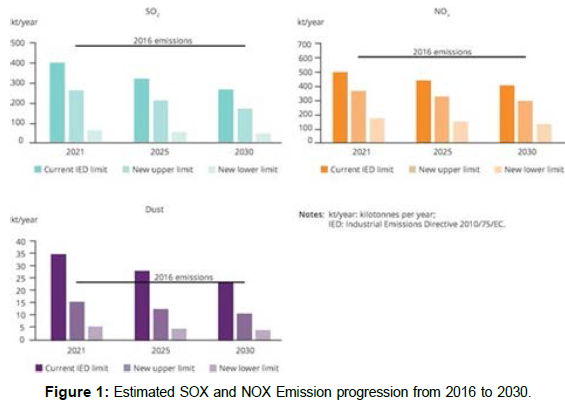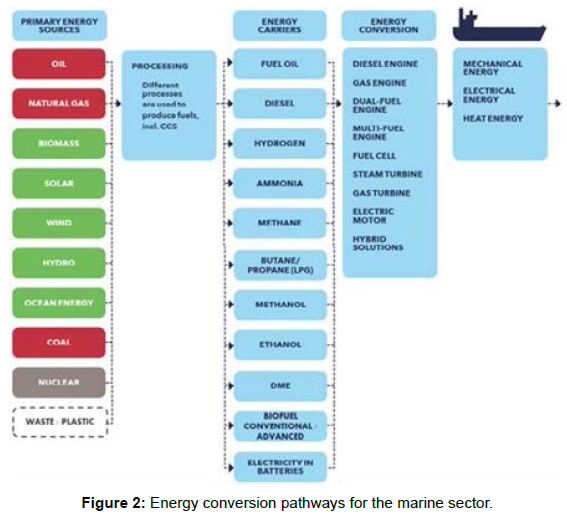Mitigating Ship Source Air Emissions in the Ocean Sub sector: Control and Compliance
Received: 01-Aug-2022 / Manuscript No. jmsrd-22-001 / Editor assigned: 03-Aug-2022 / PreQC No. jmsrd-22-001 (PQ) / Reviewed: 17-Aug-2022 / QC No. jmsrd-22-001 / Revised: 22-Aug-2022 / Manuscript No. jmsrd-22-001(R) / Published Date: 29-Aug-2022 DOI: 10.4172/2155-9910.1000357
Abstract
The issue of climate change affecting the ozone layer demands critical efforts from different sub sectors of the world carbon source emission sources cutting across the Agricultural sub sector, the oil and gas sub sector, the fossil fuel technology sub sector to mention but a few. Under the fossil fuel technology sub sector, the marine industry by having fossil fuel powered ships in the waters contributes a good measure to greenhouse gas emissions. In view of this fact the sector has instituted good number of measures to address the mitigation of ship source emissions through regulations developed by the International Maritime Organization (IMO).The work first reviewed the various air emissions control mechanisms developed for the sector. Next, the work developed a model of compliance to these rules for both flag states and port states using port state control mechanisms. Both oxides of nitrogen NOx and oxides of sulphur SOx compliance were covered in the light of IMO, Marine pollution convention MARPOL73/78 as currently amended. The theories of efficiency and responsiveness were applied in eliminating laxity in the overall ocean emissions sub sector.
Keywords: Ocean sub sector; Control and compliance; Emissions; Green house gas; Marine Transportation
Introduction
Efforts by the global community towards clean fuel and Green House Gas elimination has been hydra headed in recent years. The development pathway of the future certainly will be driven by this singular purpose. The prosperity of nations will depend on what efforts they make to adapt to the technologies which are climate change compliant as this will become the prosperity driver of several sectors the global economy, the transportation sector not being the least. To this end all development models must be sustainable. Sustainability is the single parameter that will drive future development [1-3]. Present definition of sustainability defines it as a ‘development that meets the needs of the present without compromising the ability of future generations to meet their own needs. (World Commission on Environment and Development 1987) MARPOL Chapter VI has contributed immensely to the control of air source marine pollution in the stratosphere. The regulation through limits controls emissions from ships plying the world oceans. Continual reductions of pollutions are ensured by the regulation with increasing years [4-6]. The pollution from ships via compliance by ships thus reduces as years go by. In the current year 2020 MARPOL has demanded the implementation of her more stringent requirements with reduced Sox emissions from ships of over 5000 grt from 3.5ppm to 1.5 ppm.
Literature Review
Concept of Alternative Energy Sources in Marine Transportation:
Diesel fuel energy type over the years remained the dominant energy option for marine transportation in the global maritime industry. In recent times however, the use of diesel fossil fuel type in ship propulsion led to serious problems of climate change, health and the environment, hazards associated with carbon oxides and sulphur oxide emissions as exhaust products of diesel combustion. Though the diesel the use of diesel as main propulsive energy source in ships is marked every high energy performance index and associated low cost, high availability, commercial competitiveness, etc., the environmental impacts and woes of its usage informed the serious search for alternative energy sources that could replace diesel fossil fuel type while also maintaining the high propulsive performance of diesel fuel used in the maritime operations. This has led to the development of various renewable and non-renewable energy options for use in the maritime sector, thus the concept alternative energy types for maritime transportation.
The concept of alternative energy types for maritime transportation therefore entails the development, adoption and use of other propulsive energy types and sources than diesel energy for purposes of ship propulsion. Since the main reason for the gradual phasing out of the use of diesel fossil fuel type is the associated pollution, emission and environmental change effects, such alternative energy type that must replace diesel fuel option must have capacities to overcome and/or perform better than diesel environ- mental. There exist many alternative energy options in the maritime industry. Det Norsk Veritas (DNV, 2018) provides prove that Liquefied natural gas (LNG), Hydrogen, Ammonia, Methanol, Liquefied Petroleum gas (LPG),Advanced biodiesel, hydro-treated vegetable oil (HVO), Electricity (in batteries) cum photovoltaic energy (solar/electrical energy in batteries) formed alternatives energy sources whose usage in maritime transportation is confirmed. DNV (2018) argues that apart from diesel energy type, LNG remain the best performer; having well over 300 ships globally operated with LNG [7, 8]. The implication of this is that all the energy sources identified above including marine diesel form alternatives for marine transportation. As a result, the propulsive performances of the variously identified energy options, their availability, cost, scalability, environmental performances, cum capacity of the ship-owners to adopt and diffuse it’s usage is therefore the basis for choice of use among them.
Materials and Method
The research adopted impact assessment method to estimate the effects of the new policy on the industry using revealed preference approach available in the Sox and NOX data estimates that was got from the industry. These data are valid estimates of the revealed direction of pollution in the years of estimation.
Research Findings
The Sox and NOx set out by MARPOL has required a technology change beginning from January 2020 thus forcing ship operators to diversify in order to comply thus bringing about a new regime of compliance in the cur- rent shipping and maritime industry. This new regime of compliance just in line with the expected figures will consistently reduce emissions coming from the maritime sector over the years making 2030 expected emissions the least compared to the current year emissions. In line with the more stringent restrictions brought about by the MARPOL VIregulation, ships are expected to diversify their source to use of more alternative energy sources such as Liquefied natural gas LNG thus creating the need for LNG bunkering facilities. Marine engine builders are then required to produce new vessel fuel sources from compliant fuel sources only. The big marine engine builder Wartsilla is already complying with this rule. New vessels built in the period of the twenties will certainly comply with the MARPOL VI more stringent requirements (Figures 1, 2).
More research is thus expected in the development of cleaner fuel sources as expressed in figure 2 to meet the more stringent rules. Fuel cells ammonia fired ships and other less NOx and Sox containing marine fuel sources will be used all in a bid to comply with new rules.
Thus we have entered a new regime known as the compliance regime in the maritime industry and this new regime will bring about the required gas emissions reduction necessary to bring about the protection of the ozone layer. The breakage of the ozone layer in the Northern hemisphere was naturally healed based on reduction in the use of fuels brought about by the COVID 19 stay at home order.
Natural forces may have a way of instigating actions that will bring about balance of the ozone layer science is yet discover this.
Conclusion
The implementation of 2020 MARPOL has brought a lot of innovations into the marine air pollution sector causing ships and their owners to take steps towards diversification to remain compliant.
Alternative energy as well as gas has been the latest areas as they contribute less to air pollution. A refinery also has invested more in order to produce fuel that will comply with the new MARPOL convention requirements.
Acknowledgement
We thank all the patients who participated in the trial, the referring physicians and the local investigators who contributed to the trial, and the technicians who did the labeling and the scans.
Funding
The study was funded intramurally.
Competing Interests
All authors declare no competing interests.
Author Contributions
All authors planned the study. MH screened control patients and performed mixed meal testing. KA and PW did PET or CT readings. MH, KA, and PW did the analysis and wrote the first draft of the manuscript. All authors critically proved data, edited and approved the manuscript.
Data Availability
All data is available from the corresponding author on request.
Ethics Approval
The study was approved by the local ethics committee (Ethikkommission Nordwestund Zentralschweiz, Basel, Switzerland, EKBB 163 or 12).
Consent to participate
Informed consent was obtained from all individual participants included in the study.
Consent to publish
All authors approved the manuscript for submission.
References
- Veritas DN (2018) Comparison of Alternative Marine Fuels. 3: C8I1KZ-1.
- Shaaban M, Peng Q, Hu R, Wu R, Lin S, et al. (2015) Dolomite application to acidic soils: a promising option for mitigating N2O emissions. Environ Sci Pollut Res Int.
- Report of the World Commission on Environment and Development: Our Common Future, chapter 2: towards sustainable development. Retrieved from UN documents.
- Butler D (2013) Investigating journals: The dark side of publishing. Nature 495: 433-435.
- Bohannon J (2013) Who's Afraid of Peer Review? Science 342: 60-65.
- Watson JD, Crick FH (1953) Molecular structure of Nucleic Acids: A structure for deoxyribose nucleic acid. Nature 171: 737-738.
- Kendrew JC, Bodo G, Dintzis HM, Parrish RG, Wyckoff H (1958) A three-dimensional model of the myoglobin molecule obtained by X-ray analysis. Nature 181: 662-666.
- Wilmut I, Schnieke AE, McWhir J, Kind AJ, Campbell KH (1997) Viable offspring derived from fetal and adult mammalian cells. Nature 385: 810-813.
Indexed at, Google Scholar, Crossref
Indexed at, Google Scholar, Crossref
Indexed at, Google Scholar, Crossref
Indexed at, Google Scholar, Crossref
Indexed at, Google Scholar, Crossref
Citation: Onyemechi C (2022) Mitigating Ship Source Air Emissions in the Ocean Sub Sector: Control and Compliance. J Marine Sci Res Dev 12: 357. DOI: 10.4172/2155-9910.1000357
Copyright: © 2022 Onyemechi C. This is an open-access article distributed under the terms of the Creative Commons Attribution License, which permits unrestricted use, distribution, and reproduction in any medium, provided the original author and source are credited.
Share This Article
Recommended Journals
Open Access Journals
Article Tools
Article Usage
- Total views: 1589
- [From(publication date): 0-2022 - Apr 04, 2025]
- Breakdown by view type
- HTML page views: 1257
- PDF downloads: 332


